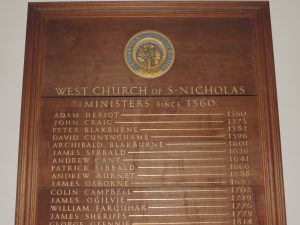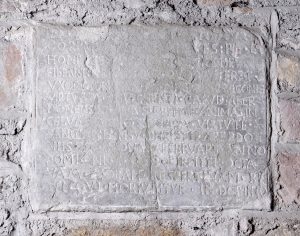This year there has been celebration of the 500th anniversary of Martin Luther posting his ‘95 theses’ on the door of All Saints’ Church in Wittenberg, Saxony on 31st October 1517. This is taken as the start of the Reformation, although it was a further 43 years before it properly reached Scotland, in August 1560.

However, things had been changing for a number of years and came to a head during 1559-60. This blog is going to focus on the first Protestant minister of Aberdeen, Adam Heriot. He was born in Trabroun, East Lothian in 1514. He matriculated at St. Leonard’s College, St. Andrews in 1543 and became an Augustinian canon at the cathedral in St. Andrews. As the challenges to the established Roman Catholic doctrine grew, Adam Heriot started to question his own beliefs and in 1558 he became a Protestant. It seems that he might have briefly been a minister in St. Andrews in 1559 before settling in Aberdeen where he remained until his retirement in 1573. In August 1560 he was appointed as the first protestant minister to the Kirk of St Nicholas in Aberdeen. In the West Kirk there is a board listing all the protestant ministers of the Kirk. His name tops the list as shown in the photograph.
His stipend was fixed at £17, which he received from the revenues of the town, but the magistrates presented to him annually a suit of black clothes (‘doublet and hose, all in black’), and other necessities, to the value of £2.50, besides a donation of about 85p in money, for house rent.
Not a great deal is known of his ministry in Aberdeen. It must have been a time of considerable turmoil and it was not until 10th December 1562 that a Kirk Session met for the first time. In 1564 there was a visit by John Knox who stayed for several weeks including preaching in the Kirk. It is presumed much of this time would have been spent on ‘purging’ the local church of Roman influence and advising on reorganisation. Adam Heriot has been described as being ‘an eloquent preacher and well seen in scholastic divinity’. On an unknown date, he married Euphemia Scheves. She died in February 1569 and he had a plaque prepared in her memory. It still remains in the wall of what is now St John’s Chapel (the Oil Chapel). It is, unfortunately, illegible but is shown in the second photograph.

He did not keep good health and in 1573 he was forced to retire. He moved back to St Andrews, where he had retained a manse. He died there on 28th August 1574 of apoplexy (possibly a stroke). An obituary says ‘greatly beloved of the citizens for his humane and courteous conversation, and of the poorer sort much lamented, to whom he was in his life very beneficial’.